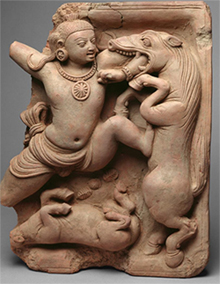With the Gupta period, India entered upon the classical phase of sculpture. Comment while reflecting on the features of the sculptural art developed during the Gupta period. (150 words)
Sakshi Education
By Srirangam Sriram, Sriram's IAS, New Delhi.


The artistic activity continued after the Kushana and Satavahana rule in north India.
 In the Gupta period all the trends and tendencies of the artistic pursuits of the proceeding phases reached their culmination in a unified plastic tradition of supreme importance in Indian History. Gupta sculpture thus is the logical outcome of the early classical sculpture of Amravati and Mathura. Its plasticity is derived from that of Mathura and its elegance from that of Amravati.
In the Gupta period all the trends and tendencies of the artistic pursuits of the proceeding phases reached their culmination in a unified plastic tradition of supreme importance in Indian History. Gupta sculpture thus is the logical outcome of the early classical sculpture of Amravati and Mathura. Its plasticity is derived from that of Mathura and its elegance from that of Amravati.
Gupta art is beautiful in both outer form and inner inspiration. Beauty and virtueserved as ideals of the age.By the efforts of the centuries, techniques of art were perfected, definite types were evolved, and ideals of beauty were formulated with precision. The Gupta sculptures remained models of Indian art for all time to come.
Theage of the Guptas followed. The Gupta period is popularly known as the Golden Age in the history of India.
The main centres of Buddhist artduring this period were Mathura, Sarnath and Nalanda in the north.The other places where we getto see Gupta sculptures are the Vishnu sculptures in Udayagiri rock-cut Caves, Dhamekstupa at Sarnath, Bhitargaon, Buddhist caves in Ajanta, Ahichchattra, and DasavataraTemple in Deogarh.
Features of Gupta sculptural art
The main centres of Buddhist artduring this period were Mathura, Sarnath and Nalanda in the north.The other places where we getto see Gupta sculptures are the Vishnu sculptures in Udayagiri rock-cut Caves, Dhamekstupa at Sarnath, Bhitargaon, Buddhist caves in Ajanta, Ahichchattra, and DasavataraTemple in Deogarh.
Features of Gupta sculptural art
- High relief: There are many sculptures done in high relief. In Ajanta, the rock surface was sophisticatedly treated with the Buddhist theme and motifs in high relief. The halo of Buddha, the decorative elements on the large size sculptures and stupasshow the mastery of artists over the stone carving.
- Bas-relief: Since the sculptures at Ajanta were carved in impressive size, the sculptors followed the bas-relief technique. The Buddha images and stupadecorations are carved in live rock with three fourths of the image emerging out.
- Rounded sculpture: For the first time the Hindu gods and subjects were carved in rounded shapes during Gupta period. The three dimensional effect is achieved in all rounded sculptures of Gupta age.
- Form modelling: The delicate modelling of forms with meditative repose rendered the Buddha and Bodhisattva figures of the Gupta period most attractive.
- Ornamentation: The Gupta figures are carved with elaborately carved ornamental details which make the divine figures very special in appearance.
- Terracotta art: The art of terracotta and casting figures in stucco reached its zenith in this period. The artist tried clay figurines on a small scale whereas the stucco figurines are in large dimensions. The terracotta figurines were used in the brick temples.
- Bodily features: The eyes of Gupta sculptures are beautifully shaped half closed, in yogic posture. The face is generally oval shaped with sharp features. The drapery is light and clings to the body, exposing the softness of the body.
- Metal sculpture: The Gupta artists showed an equal ingenuity in the carving of metal images also.
 In the Gupta period all the trends and tendencies of the artistic pursuits of the proceeding phases reached their culmination in a unified plastic tradition of supreme importance in Indian History. Gupta sculpture thus is the logical outcome of the early classical sculpture of Amravati and Mathura. Its plasticity is derived from that of Mathura and its elegance from that of Amravati.
In the Gupta period all the trends and tendencies of the artistic pursuits of the proceeding phases reached their culmination in a unified plastic tradition of supreme importance in Indian History. Gupta sculpture thus is the logical outcome of the early classical sculpture of Amravati and Mathura. Its plasticity is derived from that of Mathura and its elegance from that of Amravati.Gupta art is beautiful in both outer form and inner inspiration. Beauty and virtueserved as ideals of the age.By the efforts of the centuries, techniques of art were perfected, definite types were evolved, and ideals of beauty were formulated with precision. The Gupta sculptures remained models of Indian art for all time to come.
Published date : 26 Oct 2020 01:21PM













